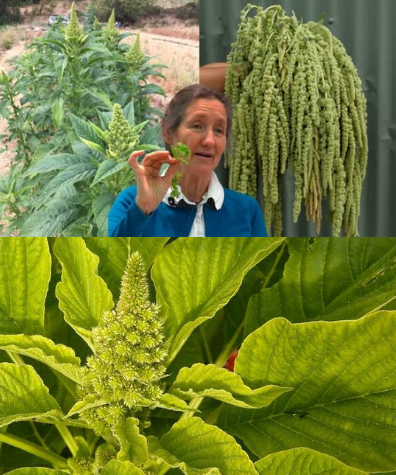
Introduction
Imagine a radiant plant, glowing ruby red or golden in the sunlight, quietly thriving in your garden. It’s not just beautiful—it’s one of the most nutrient-dense foods on the planet. Meet amaranth, an ancient grain and leafy green that sustained civilizations for thousands of years, now reemerging as a wellness powerhouse. Packed with complete protein, fiber, antioxidants, and a spectrum of vitamins and minerals, amaranth is one of 2025’s most underrated health heroes. Whether you want to boost immunity, support heart health, or fuel your body on a plant-based diet, this versatile crop is ready to deliver.
What Is Amaranth and Why It Matters
Amaranth (Amaranthus spp.) is unique because it’s both a grain and a leafy green. Ancient cultures like the Aztecs and Incas valued it for its resilience, flavor, and nutrition, and today’s health enthusiasts are rediscovering its benefits. The seeds are gluten-free, the leaves are rich in vitamins, and the plant itself is easy to grow almost anywhere. It’s sustainable, affordable, and a nutritional powerhouse—making it a smart choice for both home gardeners and conscious eaters.
Nutritional Profile: Why Amaranth Deserves Superfood Status
Amaranth rivals popular health foods like quinoa and kale with its impressive nutrient lineup.
- Protein: About 14g per 100g cooked grain—complete with all essential amino acids.
- Fiber: Roughly 7g per 100g cooked grain for digestive health.
- Vitamin A: Around 50% RDI in raw leaves.
- Vitamin C: Up to 70% RDI in raw leaves.
- Calcium: 47mg in cooked grain and 159mg in leaves.
- Iron: 2.1mg in grains and 2.7mg in leaves.
- Antioxidants: High in both seeds and greens.
What sets amaranth apart is its complete amino acid profile, which is rare for a plant source and makes it ideal for vegetarians, vegans, and anyone needing clean, complete protein.
Six Powerful Health Benefits of Amaranth
Supports Heart Health
Amaranth’s fiber, potassium, and plant sterols help lower LDL cholesterol and maintain healthy blood pressure—key factors for cardiovascular protection.
Fuels Muscles and Energy
With all nine essential amino acids, amaranth supports muscle recovery, stamina, and sustained energy—perfect for athletes and active lifestyles.
Boosts Immunity
Rich in vitamins A and C, plus potent antioxidants, amaranth strengthens immune defenses and helps keep skin healthy year-round.
Video : AMARANTHUS: Surprising Health Benefits You Should Know / Medicinal Plants / The Rural Life
Reduces Inflammation
Betalains and phenolic compounds in amaranth have anti-inflammatory properties that may help reduce chronic inflammation and joint pain.
Strengthens Bones
High levels of calcium, magnesium, and vitamin K support bone density and help reduce the risk of osteoporosis.
Improves Digestion
Its fiber content promotes healthy digestion, keeps you regular, and nourishes beneficial gut bacteria.
Six Delicious Ways to Add Amaranth to Your Diet
Amaranth Leaf Salad
Toss young amaranth leaves with cucumbers, cherry tomatoes, olive oil, and lemon juice for a fresh, nutrient-packed salad.
Amaranth Breakfast Porridge
Simmer grains in almond milk with cinnamon and top with berries for a protein-rich, filling breakfast.
Quick Stir-Fry
Sauté leaves with garlic, onions, and a splash of soy sauce for a quick, flavorful side dish.
Homemade Flatbread
Use amaranth flour with herbs and water to make gluten-free flatbreads perfect for dipping or wraps.
Green Smoothie Boost
Blend a handful of leaves with banana, spinach, and coconut water for an energizing smoothie.
Stuffed Vegetables
Fill bell peppers or zucchini with cooked amaranth, beans, and spices for a hearty plant-based meal.
Daily Habits to Make Amaranth Part of Your Routine
- Swap lettuce for amaranth leaves in wraps or salads.
- Add cooked grains to soups or grain bowls for extra protein.
- Toast amaranth grains in a dry pan for a popcorn-style snack.
- Grow it at home—amaranth is drought-tolerant and easy to maintain.
Who Should Eat Amaranth?
Amaranth is suitable for almost everyone but especially beneficial for plant-based eaters needing complete protein, athletes looking for recovery fuel, home gardeners wanting sustainable greens, and budget-conscious shoppers seeking affordable nutrition. If you’re pregnant, have digestive sensitivities, or take certain medications, check with your doctor before making it a daily staple.
Safety and Storage Tips
Always cook the grains to improve digestibility and reduce anti-nutrients. Wash leaves thoroughly, especially if foraged. Introduce it slowly if you’re not used to high-fiber foods. Store grains in a cool, dry place and leaves in the refrigerator for up to a week.
Video : Amaranth: The Prehistoric Crop You Can Still Grow 🦕
Conclusion
Amaranth isn’t just a relic from ancient agriculture—it’s a modern-day nutritional goldmine. From its complete protein content to its wealth of vitamins, minerals, and antioxidants, it’s a simple yet powerful way to support overall health. Easy to grow, versatile in the kitchen, and backed by centuries of tradition, amaranth is ready to take its place as one of 2025’s most valuable superfoods. Try it in your garden, add it to your meals, and see how this vibrant plant can fuel your healthiest year yet.


